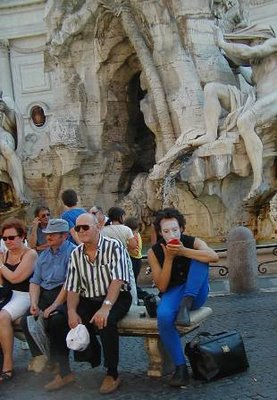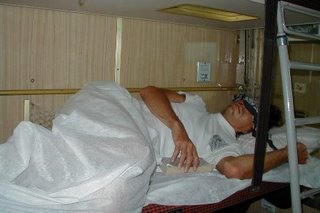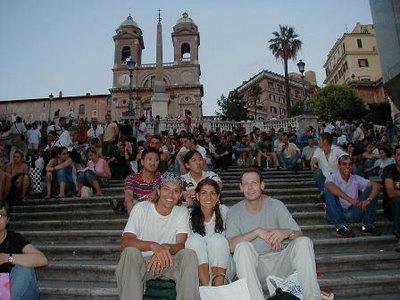 December marks the one month anniversary of the blog. It also marks the shift in the content of the web log to more personal accounts and thoughts - A step closer to the mission of this blog.
December marks the one month anniversary of the blog. It also marks the shift in the content of the web log to more personal accounts and thoughts - A step closer to the mission of this blog.‘A Diary of the Mundane -An Opinion on Architecture and Urban Design -One Voice’
The importance of travel:
Within the academic world of architecture there is a phenomenon referred to as “studio life”. This is the life of a student associated with the studio component or design classes taught at architecture schools across the country. These courses differ slightly based on the curriculum of the associated school, yet one thing remains the same – students are encouraged to spend vast amounts of time in design studios. This is understandable because most studio courses are in the 5 credit range. Approximately 10 hours a week to be dedicated to study not including the actual courses time. (2 hours study outside of class for every 1 credit.)
The studio has taken on a much greater persona.
The studio is a ‘home away from home – or dorm, or fraternity / sorority or apartment’ it is located in the school of architecture which is typically situated on campus. The studio is a private study hall and a social place to hang out. When I was at the University of Nebraska, I for argument sake completely moved into the college of architecture – I studied (worked) there, I ate there, I slept there, and in fact I even took dates there. (This is as far as I will take this example.) What this routine produces is the 24-hour-work-day where there is no separation between design (work) time and personal time. This lifestyle helps solidify the future architect’s addiction for constantly working on design. (The incapability to stop designing on a project is a catastrophic flaw of architects, as noted by many accounting departments in design firms). This habit also contributes to poor time management and procrastination, inevitably spiraling into a myth and aspiration of the architecture student to burn the midnight oil, in the name of design.
Yet, in my mind, these are not the most problematic of the issues of a poorly run studio course. (Poorly run – I will address this negative connotation in the next paragraph) The most problematic is the inbreeding of ones own perceptions of architecture.
The studio professor cultivates these activities. The professor sets in motion the idea that students should take up residence in the space called ‘studio’ and share life experiences with their classmates. It is understandable - what professor wouldn’t want their student to work 24 hours a day on their assignment?
Any undergraduate who has taken an architecture studio course has a story - midnight professor/student crits, the “cool” professor having food delivered to the studio after-hours with a note “its almost over”, or projects being due in the evening (8:00pm). My favorite story is from a friend who graduated from Syracuse University. He was working toward a deadline during his second year when around 2:00am his professor came into the room after a night on the town. The professor looked around and then started taking the empty chairs of the students not currently working in the studio and placing them on their drafting boards in a somewhat forceful action. The students that were in studio all got the hint and the students that came the next day were fearful of any outcomes, particularly when it came time for grades.
Not all professors are like that; my third year architecture studio professor at the University of Nebraska was different. Although, Dr. Ted Wright did want us to work in the studio and advised us to participate in the “studio life”, he also instilled time management skills – in his words “necessary for success”. He pushed us to eat healthy and to “work hard, play hard and get eight hours of sleep”. Somehow he also managed to eliminate any sense of cut-throat competition between students. For me, this studio became the most open and interactive, sharing ideas and deep thoughts about architecture and the projects that we were all working on.
The most problematic is the inbreeding of ones own perceptions of architecture:
I recently participated in a student crit where the design challenge was combining programs: Laundromat and a sports bar; a hair salon and a gentlemen’s social club (didn’t John Allan do this?); most interesting, opera house and a discothèque. When discussing the latter project, I asked the student if she had been to the opera – she had not. I asked the other students, have you been to a gentlemen’s social club? – “no”, have you been to a Laundromat? – “I visited”.
How can an architect design an opera house if he/she has never been to an opera? They cannot. Some argue that designers can use the Ramsey and Sleeper’s Architecture Graphic Standards, but I disagree. I contend that this promotes stagnant ‘Encyclopedia Style Design’ simply inbreeding thoughts without an induction system to stir any true understanding of a space. Which brings me to the title of this post, ‘The Importance of Travel’ - The importance of experience, the importance of understanding through ones senses?
I participated in a charrette for a master plan and design of an entertainment retail development and new gateway to a city center on the East Coast. We were working out the issue of getting people from the parking structures located behind the retail buildings, through the retail zone to the street. I had just returned from London and mentioned the scale and charm of London’s shopping arcades – It became a major design element in the project.
During the same charrette we were struggling with a site/planning condition that created an awkward void enclosed by retail on the North, South and South-West, a parking structure on the West side and the main street on the East. The program did not require additional retail and the early sketches filled the space with parking. After reviewing the parking numbers and realizing that we could rearrange to leave this area void – I proceeded to mention the nice surprise that I got when turning a corner in cities of Italy and finding a piazza. These urban open spaces were created many times by the void of buildings and conversion of paths rather than any major master-plan. When I was in Otranto, Italy the piazzas were places to meet up, play street ball or park your Vespa. Many of my fondest memories were sitting at a café on the corner of a piazza drinking a cappuccino, eating a ginger biscuit and watching the locals. (Needless to say) We left the space open.
Later that day, a colleague came up to me and jokingly mentioned that I needed to stop traveling.
This day is my best example and argument for the need of one to travel in order to fully understand the environment that we are designing. Of course I could get all of these ideas from a book and I am sure that I learned about them in my 9:00am Architectural History class where for two hours (with the lights off) a teacher showed slides and all the students got their required shut-eye. Yet, to really understand the scale, the proportions and the social themes, one has to see it physically, one has to experience it.
 When it is time for me to teach a studio course, I have a choice – I can be the studio professor that I had as a student who requested that the undergraduate buy these three important books that will cost $70.00 or to be a studio instructor that gives the students a choice to either buy the important books –or- take that $70.00 and go to the opera, go see a show / concert, become a member of a museum (I recommend the Frick Collection), or just go to the ‘hole in the wall’ coffee house that has the greatest jazz or poetry readings in the area. Do your laundry at the laundromat, buy food at the farmer’s open air market and/or not defer your jury duty for the third time …
When it is time for me to teach a studio course, I have a choice – I can be the studio professor that I had as a student who requested that the undergraduate buy these three important books that will cost $70.00 or to be a studio instructor that gives the students a choice to either buy the important books –or- take that $70.00 and go to the opera, go see a show / concert, become a member of a museum (I recommend the Frick Collection), or just go to the ‘hole in the wall’ coffee house that has the greatest jazz or poetry readings in the area. Do your laundry at the laundromat, buy food at the farmer’s open air market and/or not defer your jury duty for the third time …
-To be there and engaged is the only way one can capture the real meaning of a space.-
On a Tangent:
Can someone understand and “design” a successful and advanced foreign policy if they have limited foreign travel and have not bare witness to the complexity of traditions, customs, philosophies and opinions?
"George W. Bush had only visited Mexico, Israel and China before
becoming president…”
A quote from CNN's Walter Rodgers:
CNN Student News: Judy Woodruff's Inside Politics
http://cnnstudentnews.cnn.com/TRANSCRIPTS/0312/17/ip.00.html
“It is ludicrous to simplify civilizations to black and white, right and wrong, good and bad, 0’s and 1’s. We are all humans, with traditions, and customs, philosophies and opinions. The more one learns about others, the more we will learn about ourselves. Understanding leads to open-mindedness that leads to acceptance.”
A quote from J. Steven Lovci
http://jstevenlovci.blogspot.com/2006/11/new-hope.html
“The most enjoyable accounts is when I have the opportunity to sit down at a ‘salon de tea’ or café, or coffee bar - take off all my filters and just observe - soaking in with my senses everything that one moment in time has to give to me.”
A quote from J. Steven Lovci
http://jstevenlovci.blogspot.com/2006/11/moment.html
